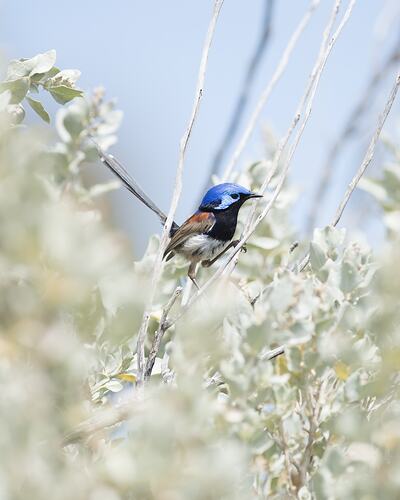General Description
A small bird with a long tail held in a cocked position. The breeding male is brightly coloured, with a blue crown and sides of the head, and the shoulder patch is a rich chestnut brown. The depth and variety of colours in the male varies among the four subspecies, distributed across the Australian mainland. Non-breeding males, females and young birds are brownish grey. Females in the Northern Territory and Western Australian populations have a blue-grey (rather than brown-grey) plumage. Body size up to 12 cm.
Biology
The birds feed around the base of small shrubs, and seldom stray into the open. Some food may be found among the bark and foliage of short trees and grasses. Its diet consists of insects and a small amount of seeds. The male is often mistakenly believed to have a harem of females. The small groups actually consist of an adult female with younger or non-breeding birds. As they have a wide range, they have been recorded breeding in almost every month of the year. The nest is an oval-shaped dome, constructed of grasses, and placed in a low shrub. The female alone constructs the nest and incubates the eggs, but is assisted by other group members in feeding the chicks. The call is a mechanical 'triri-tirirrit-tirit-trit-tirrririt-trit-tirrit' sound only in the breeding season.
Distribution
Across Australia.
Habitat
Forest, woodland and shrubland habitats.
More Information
-
Animal Type
-
Animal SubType
-
Brief Id
Small bird with long tail. Male has a bright blue head and chestnut brown shoulder.
-
Colours
Brown, Blue, Black, Grey
-
Maximum Size
14 cm
-
Habitats
-
Diet
Insects
-
Diet Categories
Insects
-
Endemicity
-
Commercial
No
-
Conservation Statuses
CITES: Not listed, FFG Threatened List: Not listed, EPBC Act 1999: Not listed, IUCN Red List: Least Concern
-
Taxon Name
-
Common Name
Variegated Fairy-wren
-
Kingdom
-
Phylum
-
Subphylum
-
Class
-
Order
-
Family
-
Genus
-
Species Name
lamberti













